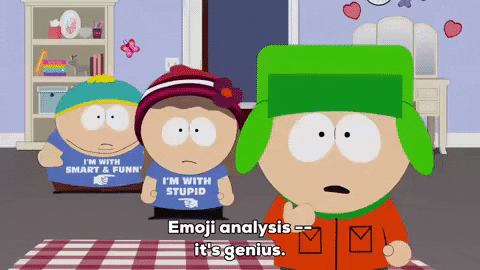Academic Paper: Discussion and Analysis
5 min read•june 18, 2024
Dylan Black
AP Research 🔍
28 resourcesSee Units
Introduction
After presenting your data and results to readers, you have one final step before you can finally wrap up your paper and write a conclusion: analyzing your data! This is the big part of your paper that finally takes all the stuff you've been talking about - your method, the data you collected, the information presented in your literature review - and uses it to make a point!
The major question to be answered in your analysis section is simply "we have all this data, but what does it mean?" What questions does this data answer? How does it relate to your research question? Can this data be explained by, and is it consistent with, other papers? If not, why? These are the types of questions you'll be discussing in this section.

Source: GIPHY
Writing a 🔥 Discussion and Analysis
Explain What Your Data Means
The primary point of a discussion section is to explain to your readers, through both statistical means and thorough explanation, what your results mean for your project. In doing so, you want to be succinct, clear, and specific about how your data backs up the claims you are making. These claims should be directly tied back to the overall focus of your paper.
What is this overall focus, you may ask? Your research question! This discussion along with your conclusion forms the final analysis of your research - what answers did we find? Was our research successful? How do the results we found tie into and relate to the current consensus by the research community? Were our results expected or unexpected? Why or why not? These are all questions you may consider in writing your discussion section.

You showing off all of the cool findings of your research! Source: GIPHY
Why Did Your Results Happen?
After presenting your results in your results section, you may also want to explain why your results actually occurred. This is integral to gaining a full understanding of your results and the conclusions you can draw from them. For example, if data you found contradicts certain data points found in other studies, one of the most important aspects of your discussion of said data is going to be theorizing as to why this disparity took place.
Note that making broad, sweeping claims based on your data is not enough! Everything, and I mean just about everything you say in your discussions section must be backed up either by your own findings that you showed in your results section or past research that has been performed in your field.
For many situations, finding these answers is not easy, and a lot of thinking must be done as to why your results actually occurred the way they did. For some fields, specifically STEM-related fields, a discussion might dive into the theoretical foundations of your research, explaining interactions between parts of your study that led to your results. For others, like social sciences and humanities, results may be open to more interpretation.
However, "open to more interpretation" does not mean you can make claims willy nilly and claim "author's interpretation". In fact, such interpretation may be harder than STEM explanations! You will have to synthesize existing analysis on your topic and incorporate that in your analysis.

Liam Neeson explains the major question of your analysis. Source: GIPHY
Discussion vs. Summary & Repetition
Quite possibly the biggest mistake made within a discussion section is simply restating your data in a different format. The role of the discussion section is to explain your data and what it means for your project. Many students, thinking they're making discussion and analysis, simply regurgitate their numbers back in full sentences with a surface-level explanation.
Phrases like "this shows" and others similar, while good building blocks and great planning tools, often lead to a relatively weak discussion that isn't very nuanced and doesn't lead to much new understanding.
Instead, your goal will be to, through this section and your conclusion, establish a new understanding and in the end, close your gap! To do this effectively, you not only will have to present the numbers and results of your study, but you'll also have to describe how such data forms a new idea that has not been found in prior research.
This, in essence, is the heart of research - finding something new that hasn't been studied before! I don't know if it's just us, but that's pretty darn cool and something that you as the researcher should be incredibly proud of yourself for accomplishing.
Rubric Points
Before we close out this guide, let's take a quick peek at our best friend: the AP Research Rubric for the Discussion and Conclusion sections.

Source: CollegeBoard
Scores of One and Two: Nothing New, Your Standard Essay
Responses that earn a score of one or two on this section of the AP Research Academic Paper typically don't find much new and by this point may not have a fully developed method nor well-thought-out results. For the most part, these are more similar to essays you may have written in a prior English class or AP Seminar than a true Research paper. Instead of finding new ideas, they summarize already existing information about a topic.

Source: GIPHY
Score of Three: New Understanding, Not Enough Support
A score of three is the first row that establishes a new understanding! This is a great step forward from a one or a two. However, what differentiates a three from a four or a five is the explanation and support of such a new understanding. A paper that earns a three lacks in building a line of reasoning and does not present enough evidence, both from their results section and from already published research.

Source: GIPHY
Scores of Four and Five: New Understanding With A Line of Reasoning
We've made it to the best of the best! With scores of four and five, successful papers describe a new understanding with an effective line of reasoning, sufficient evidence, and an all-around great presentation of how their results signify filling a gap and answering a research question.
As far as the discussions section goes, the difference between a four and a five is more on the side of complexity and nuance. Where a four hits all the marks and does it well, a five exceeds this and writes a truly exceptional analysis. Another area where these two sections differ is in the limitations described, which we discuss in the Conclusion section guide.

Source: GIPHY
Conclusion
You did it!!!! You have, for the most part, finished the brunt of your research paper and are over the hump! All that's left to do is tackle the conclusion, which tends to be for most the easiest section to write because all you do is summarize how your research question was answered and make some final points about how your research impacts your field. Finally, as always...

Source: GIPHY
Browse Study Guides By Unit
🤨Unit 1 – Question & Explore
🔎Unit 2 – Understand & Analyze
👥Unit 3 – Evaluate Multiple Perspectives
💡Unit 4 – Synthesize Ideas
🗣Unit 5 – Team, Transform, & Transmit
🎓The Academic Paper
✏️Frequently Asked Questions
📚Study Tools

Fiveable
Resources
© 2025 Fiveable Inc. All rights reserved.